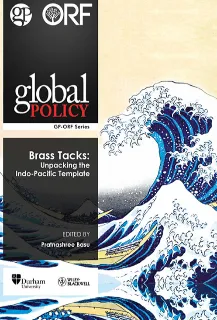Spanning a vast geographical expanse and covering two ocean systems, the Indo-Pacific comprises some of the fastest growing developing economies in the world, houses the most active seaports, and accounts for the bulk of global maritime trade. Unsurprisingly, global and intra-regional interactions have come to be inextricably tied to the geopolitical and geoeconomic realities and shifts in the Indo-Pacific. This part of the world has consequently come to occupy a place of significant multi-stakeholder prominence across the globe, resulting in both cooperative and competitive equations of power over access to and use of resources, connectivity, and infrastructure. While the pre-pandemic world was already grappling with geopolitical, geoeconomic and technological complexities, the onset of the most challenging global health crisis ever has propelled countries around the world into unanticipated uncertainties and accelerated and recalibrated global interactions and decision-making in unprecedented ways. Underlying these interconnections is the uncertainty and ambiguity with respect to China’s place and role given the significant proportions of apprehension that it has given rise to.
This volume of the GP-ORF Series will explore the currents that characterise a geopolitically tense Indo-Pacific with the aim to untangle or decongest this geographical space, which has in a sense become encumbered by a multitude of strategic ascriptions and ensuing policy prescriptions. The edition comprises four sections inquiring into the key developments and their perceived and actual implications alongside considered approaches that inform both intra and extra-region interactions. Divided into the broad categories of strategy, economy, regional politics and critical technologies, these sections also offer policy directions in response to shifts in the regional contour. The not-so-smooth rise of China; the increasing role of aspirational intra-regional countries; a renewed realisation of the significance of maritime commerce and its complex and multi-layered interaction with political dynamics; the reliance on maritime trade routes for supplies of energy and the uncertainties; and opportunities posed by rapid advances in critical technologies are some of the key issues that underpin and shape developments in the Indo-Pacific.
The first section, ‘Geostrategy: The Geometry of the Indo-Pacific Construct,’ explores the many definitions and constructs for what the Indo-Pacific stands for—all of which are not equivalent—and how they are impacting regional and global alignments of power. This section traces the evolution of the Indo-Pacific as a geostrategic construct and evaluates if the Indo-Pacific is a constructive project with the potential to bind a part of the world that is aspirational and committed to the preservation of peace and stability, or if it is just a hastily put together construct that is grappling to bring together like-minded countries to contain China. This section analyses the role of China, India and the US as Indo-Pacific powers, key to the making and unmaking of regional and global geopolitical equations.
The focus of the second section, ‘Geo-economy: Repercussions of Adaptive Expectations,’ centres around the geoeconomic interactions in the Indo-Pacific, exploring how economic engagements stand to characterise and impact the politically heavy dynamics of the region. It looks at how the ongoing pandemic has underscored the already acknowledged need for diversifying reliance on traditional nodes of manufacturing alongside the building of resilient supply chains; the ways in which competing architectures of trade and investment interact and influence bilateral and multilateral ties; and the imperative of cooperation in energy security particularly in the context of ensuring seamless trade flows across some of the busiest sea lines of communication, which traverse the waters in the Indo-Pacific. India’s position and economic engagements, its characteristic trade dilemma and future choices for global integration is another aspect of consideration. Recognising the multi-dimensional challenges such as climate change, sea-level rise, ocean acidification, and extreme weather events, this section also looks at emerging areas of collaboration that are prompting countries to gravitate towards the ‘blue economic model’ of sustainable and viable growth.
‘Competing Polarities: Regional ordering and External Balancing,’ the third section, acknowledges that the Indo-Pacific is caught between responding to developments and devising approaches that are best suited to make room for the expanding scope of external balancing in the region. Geopolitics will largely play out in this spectrum of cooperation and contest. In this background, this section investigates the challenges for operationalising ASEAN centrality in an already fraught Indo-Pacific; the mushrooming of minilateral forums and whether they stand to achieve partnerships of function especially as middle powers like Australia, Japan, and India begin to shoulder a larger share of intra-region security dynamics; and the geopolitical tightrope that countries in Southeast Asia must manoeuvre amidst regional and external pulls and pressures. From the perspective of New Delhi, it assesses the viability of utilising the Andaman and Nicobar Islands as a springboard for India’s involvement in the Indo-Pacific.
The final section, ‘Analytics and Ambiguity: The Critical Technology Frontline,’ studies whether critical technologies have become the new frontline in the Indo-Pacific. Digital responses are becoming ever more critical, leading to the shrinking of physical distances and communication timelines and demanding responses that are adaptive and swift. The adoption of and adaptation to technologies connected with the fourth industrial revolution, such as 5G, artificial intelligence, nanotechnology, robotics and quantum technology, will define the nature and scope of innovation, economic progress and social development within countries. With scope for both positive and negative disruptions, critical technologies offer opportunities for collaboration while also being susceptible for use as the tools of modern warfare. In a region that is already witness to contested spaces, the role of technology becomes rife with opportunities and as countries in the Indo-Pacific frame their approaches to critical technology issues through the lens of national security.
This volume sets out to provide a meaningful template for the Indo-Pacific construct. In doing so, it highlights the prime drivers impacting countries in the region while also focusing on the external forces that align with or affect the evolution of the Indo-Pacific, with the objective of informing stakeholders, policy practitioners and researchers with a comprehensive yet nuanced understanding of a region that will shape global interactions in the coming years.
The views expressed above belong to the author(s). ORF research and analyses now available on Telegram! Click here to access our curated content — blogs, longforms and interviews.

 PDF Download
PDF Download



 PREV
PREV


